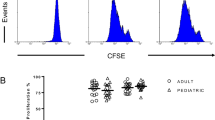Summary
The PHA-responsiveness in cell-culture of mononuclear cells obtained in acute leukemia from different sources, such as blood, bone marrow, lymph-nodes, leukemic pleural effusion and spinal fluid were investigated. The peripheral blood lymphocytes of all but 2 of 28 untreated patients showed extents of blastogenesis from 48 to 90%. The bone-marrow cells of 18 of the 28 patients gave high extents of blast-like cells (52 to 88%) in 5. In fact, the marrow cells of 9 patients showed blast extents only from 1 to 14%, whereas the remaining 4 patients had no marrow-cell transformation at all. Also the lymphocytes from lymph-nodes of 2 patients show low extents of blastogenesis (8.5–12.3%). Again, the mononuclear cells obtained from the spinal fluid in 7 patients affected by meningeal leukemia, and from the pleural effusion in 1 patient did not undergo any blastic transformation. The question arises whether the PHA-responsive cells from the acute leukemia peripheral blood are normal immuno-competent lymphocytes circulating in the blood, independent from the cell type of leukemia. As a consequence, it comes up whether the bone-marrow cells are PHA-responsive in the lymphocytic type of acute leukemia and PHA-nonresponsive in other cell-types of leukemia (myelo-monocytic). Thus, the PHA-cell culture of both the peripheral blood and the bone-marrow cells could aid in recognizing the cell types of leukemia one is dealing with.
Zusammenfassung
Es wurde die PHA-Reaktion in der Zellkultur mononuklearer Zellen untersucht, die man bei akuter Leukämie aus verschiedenen Quellen, wie Blut, Knochenmark, Lymphknoten, leukämischem Pleuraexsudat und Rückenmarkflüssigkeit gewann. Bei 28 unbehandelten Patienten zeigten die peripheren Lymphozyten, mit Ausnahme von 2 Patienten, alle eine Ausbreitung der Blastogenese von 48 bis 90%. Von 28 Patienten zeigten die Knochenmarkzellen bei 18 Patienten Ausbreitungen der Erythrozytenzellen (52–88%). Tatsächlich aber fanden wir in den Knochenmarkzellen von 9 Patienten nur eine Erythrozytenausbreitung von 1–14%, wobei bei 4 Patienten überhaupt keine Knochenmarkzellveränderung zu sehen war. Auch die Lymphozyten der Lymphknoten von 2 Patienten zeigen nur wenig Blastogenese-Ausbreitung (8.5–12.3%). Auch die mononuklearen Zellen, die man aus der Rückenmarkfüssigkeit von 7 Patienten, die an Hirnhautleukämie erkrankt waren, und aus dem Pleuraexsudat eines Patienten gewann, ließen keinerlei Erythrozytenveränderung erkennen. Es erhebt sich nun die Frage, ob die PHA-reagierenden Zellen im Blut bei akuter Leukämie normale immunkompetente, zirkulierende Lymphozyten sind, unabhängig vom Zelltyp der Leukämie. Daraus ließe sich folgern, daß die Knochenmarkzellen bei der akuten Lymphozyten-Leukämie PHA-reagierend sind und bei anderen Leukämien (Myelo-monozytisch) PHA-nichtreagierend. Somit könnten sowohl die PHA-Zellkulturen im peripheren Blut als auch im Knochenmark helfen, den Zelltyp der Leukämie, mit der man es zu tun hat, zu erkennen.
Similar content being viewed by others
References
Airò, R., G. Astaldi, D. Micu, P. G. Mandelli and I. Raileanu: Path. Europ.2, 437 (1967).
Alexander, P., E. J. Delorme, G. A. Currie and G. C. Sime: Proc. of the Internat. Symposium on L-Asparaginase, Paris, Nov. 28–30 (1970).
Astaldi, G.: Rivista degli Ospedali2, 1 (1970).
Astaldi, G.: Therapeut. Berichte43, 63 (1961).
Astaldi, G. and R. Airò: Souvenir of IV Asian & Pacific Congress of Hematology, Nov. 1967, pages 57–66.
Astaldi, G., R. Airò and S. Sauli: “In vitro” studies on leukemic cells. Current Research in Leukemia. Edited by F. G. J. Hayhoe, Cambridge University, pag. 139 (1965).
Astaldi, G., G. R. Burgio, I. Krc, R. Genova and A. Astaldi jr.: Lanceti, 423 (1969).
Astaldi, G. and I. Lisiewicz: Lymphocytes: Structure, Production, Functions. Casa Editrice Idelson, Napoli 1971.
Astaldi, G., L. Massimo, R. Airò and P. G. Mori: Lanceti 1265 (1966).
Astaldi, G., D. Micu, A. Astaldi jr., G. R. Burgio and I. Krc: Proc. Internat. Symposium on L-Asparaginase. Paris, Nov. 28–30 (1970).
Dameshek, W.: The H. M. Stratton Lecture. XI Congr. Int. Soc. Hematol., Sydney/Australia 1966.
Furth, R.: Sem. Hematol.6, 84 (1969).
Pileri, A., R. P. Tarocco, F. Gavosto, A. Ponzone and P. Nicola: Tumori54, 147 (1968).
Author information
Authors and Affiliations
Additional information
Supported by “The Blood Research Foundation,” Washington D.C./USA.
PHA=Phytohemagglutinin.
Paper delivered at the “Fourth International Symposium on the Biological Characterisation of Human Tumours.” Heidelberg/Germany, 21–23 April, 1971.
Rights and permissions
About this article
Cite this article
Astaldi, G., Massimo, L., Dagna, F. et al. PHA-blastogenesis in relationship to the cell-type and source in acute leukemia. Blut 24, 153–160 (1972). https://doi.org/10.1007/BF01631462
Received:
Issue Date:
DOI: https://doi.org/10.1007/BF01631462




